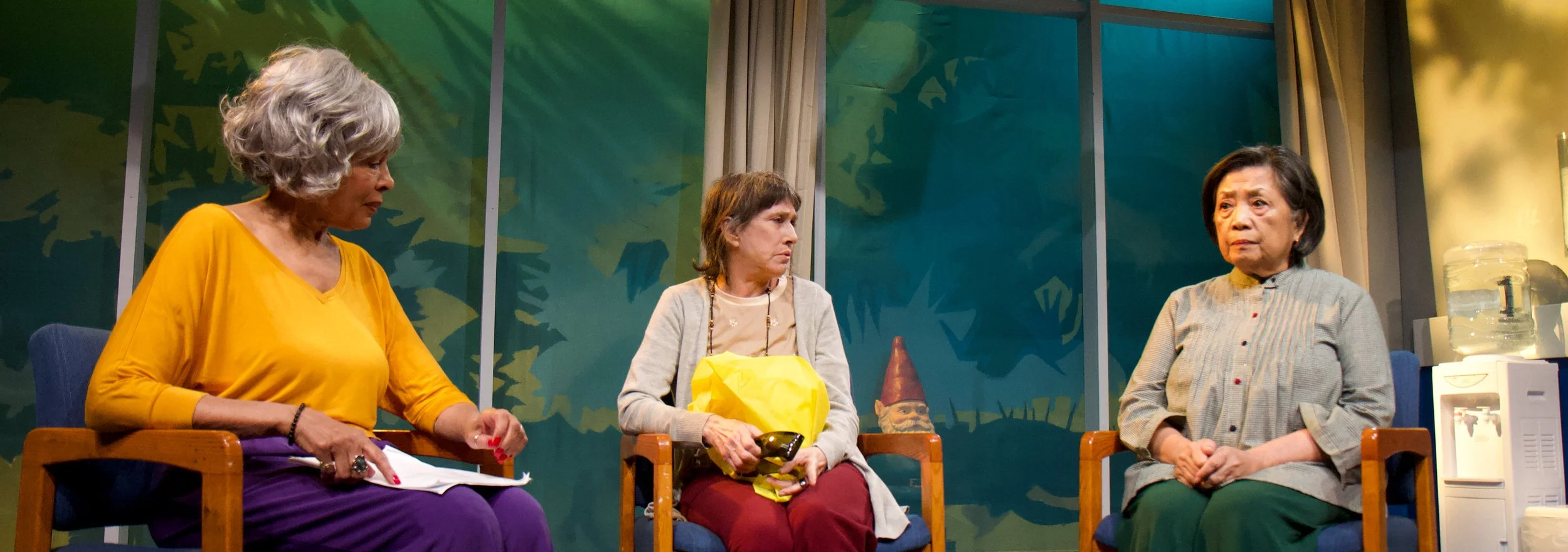At the conclusion of On the Verge, one character exclaims, "I have such a yearning for the future! It is boundless! Not annoying. Not annoying at all!" Unfortunately, in the 20% Theater Company's recent revival, Eric Overmyer's script feels boundless in its length and is more than a little annoying. While the story's three Victorian-era ladies press forward on a time-traveling expedition, the plot, weighed down by an overbearing love affair with language, never takes off.
Upon venturing into "Terra Incognita," Mary (Julie Baber), Fanny (Johanna Weller-Fahy), and Alexandra (Nina Louise Morrison) discover objects from the future (such as eggbeaters, Cool Whip, Super Soakers, and car mirrors) and absorb anachronistic knowledge through "osmosis." The actresses have a strong, warm chemistry and offer performances so imaginative that it's too bad they don't have the material to match.
They obviously relish Overmyer's alliterative and verbose dialogue (one muses, "What a succulent word! Dirigible," continuing, "Ineligible dirigible. Incorrigible dirigible. Gerbil in a dirigible."), and they deliver their lines with panache. However, the production's overemphasis on perfect diction often robs its scenes of any resonance. With sharp, choppy speech, the actors spit out their lines so precisely that their performances are more academic than dramatic. The play, which sounds very pleasant, often seems better suited to a book on tape than a stage.
Sometimes with her tongue literally pressed in her cheek, Weller-Fahy seems so excited by the lyricism of her lines that she delivers each one like a scale, rising in pitch and volume. She is much more successful with serious monologues of simpler vocabulary. When Fanny worries about what may happen to her marriage, she says, "The future looms as steady and stable as a table top." The sentence may be plain, but when Weller-Fahy sheds her gleeful demeanor, it provides a touchingly hushed pause outside the show's motor-mouth pace.
As Mary, the longwinded leader, Baber manages to make studied pronunciation sound quite natural. Her breathy excitement and good timing add a cool credibility to even the most ridiculous lines. She is at her best when getting giddy over anthropological smut: thinking about Masai warriors clad only in blouses, flirting with a cannibal, discussing mating rites. Her deep growls and shrieks of pleasure give the stiff, know-it-all Mary some shape.
Morrison steals the show as the adorable Alex. She consistently accents just the right syllable for comic effect and knows the exact moment to add a wide-eyed glance or pursed-lip squeak to quirky remarks like "trousers, ladies, are the future" or "trapezoids of destiny." She also infuses Overmyer's verbal gymnastics with much-needed flexibility. Deconstructing the word "imaginative," for example, she waves her hands, as if pulling the word apart in the air. "Image. Native. Image-native. I am a native of the image. An indigine of the imagination." Combined with one of the script's best turns of phrase, her palpable wonderment lifts the words above sound bite territory and makes a fine scene.
In their travels, the female explorers also find an array of unusual characters, including a yeti, a gas station attendant, and a lounge singer. Cliff Campbell plays every supporting role with a rubbery versatility. In contrast to the women's staccato precision, many of his characters have a sloppy style of speaking. As Nicky Paradise, a singer from the 1950s, his words slide into one another. It is a welcome departure from the women's schoolmarm talk and effectively proves Fanny's earlier prediction: "I've seen the future and it is slang." Although conversation may suffer as time wears on, Campbell makes the loss easy to swallow.
While the play is mostly an aural experience, director Portia Krieger and costume designer Denise Maroney provide some visual delights. The ladies' costumes are an amusing blend of dainty (billowing blouses, hoop skirts) and outdoorsy (large boots, earth-toned jackets), particularly their lacey, shell-lined pith helmets. One other memorable detail is the characters' discovery of "lunar snow." Illuminated by several circles of light (by Scott Needham), the actors sprinkle fistfuls of glitter into the air. As they run their fingers through the sparkling dust, it looks as though they're touching falling snow. The effect is both cosmically beautiful and wickedly inventive.
Unfortunately, these moments are too infrequent to save a show that doesn't have enough substance to justify its two hours and 15 minutes. It's telling that its most poignant point is accidental: in one of Mary's final speeches, she fires off a list of future technologies and tragedies, ending with "Ground Zero." Since the play was published in 1985, the phrase was probably describing where the atomic bomb hit Hiroshima.
In the aftermath of Sept. 11, however, the words feel chillingly contemporary. The characters may be downright giddy about what's to come, but in a world where the most familiar point of reference is catastrophe, the future doesn't look too bright.







 Amy Wilson (Photo by Sue Barr)
Amy Wilson (Photo by Sue Barr)